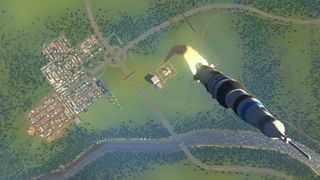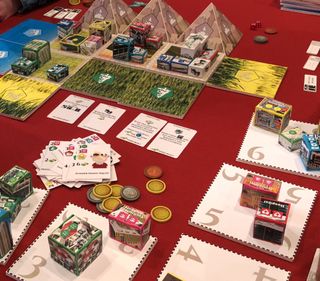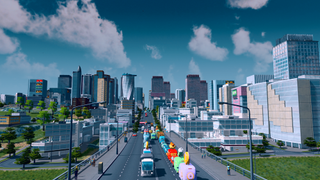Please constituents, crush dreams in the Cities: Skylines board game
The tabletop adaptation of the city builder seems like a bid for core board gamers.

City building is a perennial theme for tabletop game designers, so when Paradox Interactive announced it was going into board games it was obvious that Cities: Skylines would have to be one of them. With popular designer Rustan Håkansson (Nations) behind the game, it’s clear that this one is a bid for the core tabletop game audience. It’s much less complex than the other announced games, like Crusader Kings and Europa Universalis. Having spent some time with a prototype of the game it’s a good design, but more complex than its entry-level design goal, and doesn’t entirely cover the themes of the PC game it’s based on. Rather than a single city planner, players are rival members of a single city council getting buildings built to please lobbyists. The city planner with the most cash at the end of the game wins.
Cities: Skylines’ prototype played like a clever mix of set collection and modular board-building. Each round, players place buildings into the city in an attempt to please their constituents and lobbyists, represented by cards in their hands. Each card has a group that wants a specific set of buildings built in a specific area, like three units of residential and a unit of commercial near a beach, or several hospitals adjacent to mountains. After rolling a pair of dice, players can then choose buildings from a group based on the numbers rolled, always choosing from the smallest buildings in that group. These buildings are zoned as commercial, residential, and industrial, but can belong to rarer service categories like public safety or healthcare. Combined with a few limited abilities like placing a larger building than normally permitted or moving a previously placed building, the choices you make on your turn are simple, but have rippling consequences because your opponents care what you place as well.

See, each player can score from buildings placed every turn. That means you’re attempting to not just satisfy your own needs, but to avoid placing buildings in configurations you think other players want. If someone is placing lots of residential real estate on hills, for example, you probably don’t want to help them along by placing more—that, or you want to try and grab a few similar objectives so you can profit off of their hard work. Each turn you can give up money—that is, points—to shuffle some of your lobbyists out of your hand and pick up new ones. Hand management is key strategy of the game. It keeps your options fresh and keeps up with an evolving board. This is a set collection and hand management game, but everyone shares the same sets. The competition is all about what’s in your hand and where you place key buildings.
Building a hospital next to some mountains, rather than near a forest, can absolutely crush dreams. In one game I played, simply putting a residential development adjacent to a forest and the ocean, rather than a forest and in some hills, gave my opponent the single point he needed to win over me. It’s the same kind of tight, tense decision making and race-to-place that make games like Ticket to Ride so compelling.
Beyond the basic structure, you have special buildings that are placed as you go. Things like a recycling center that lets you get your hand options back or a tax office that redistributes wealth to the player with the least money. Håkansson said that these are the way the primary way the game scales complexity, with some affecting the players very little and others fundamentally altering the game balance by doing things like raising hand limit. When asked why, unlike the video game, the average building didn’t affect the one next door, Håkansson said that they had tried interdependency, but it “doesn’t increase the playing fun.”

If all of this sounds pretty complex for a simple, entry level game, that’s because it is. While the stated design goal is of similar complexity to Ticket to Ride, the hand management and set collection elements are actually really brain burning as of this preview. Though the early game moved at a good clip, analysis paralysis set in after a few rounds as I evaluated and re-evaluated what cards I could feasibly complete before the game ended and which I needed to watch as opponents placed buildings. Strong visual design will mitigate that factor in a finished product, but matching myriad symbols is always going to be pretty hard for a certain subset of people. As it was I’d call it a second or third modern board game to learn, not a first.
If it’s produced right, it has a really high level of table and play appeal. Placing little buildings on the grid was kinesthetically satisfying, as was the experience of having actually worked together to build a city at the game’s end. Few tabletop city builders, and none of the best ones, actually give that cooperative experience right now. It’s undeniable that the theme fits the experience, as clashing priorities between people in power lead to a unique and often strange city that satisfies some people but certainly doesn’t please everyone. Of all the board games Paradox showed off in their licensed line, it’s clear that from choice of designer to style of design, Cities: Skylines would be the one that’s a real bid for the majority of the board game audience.
The biggest gaming news, reviews and hardware deals
Keep up to date with the most important stories and the best deals, as picked by the PC Gamer team.
The Cities: Skylines board game is to be finished this year and published some time next year, but as of yet no publisher has been announced.
Jon Bolding is a games writer and critic with an extensive background in strategy games. When he's not on his PC, he can be found playing every tabletop game under the sun.
Most Popular

